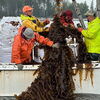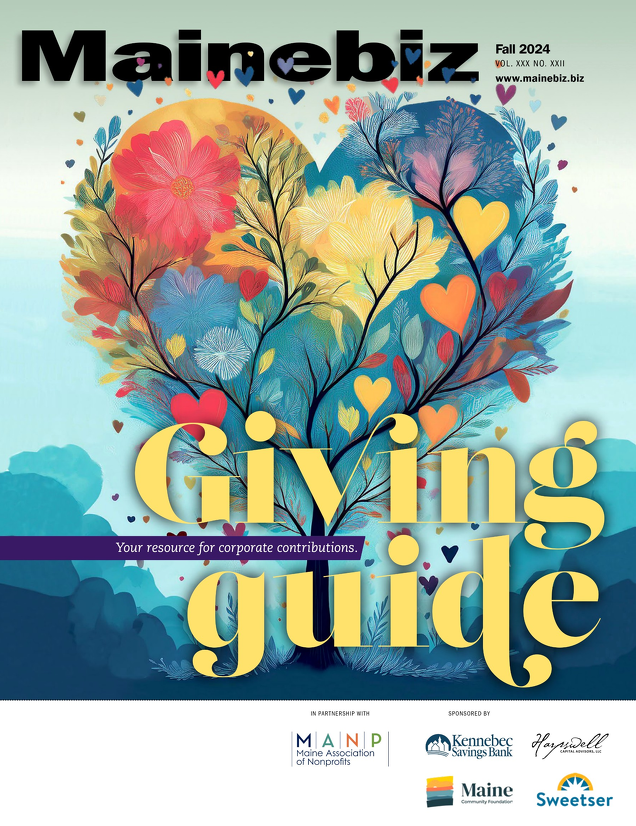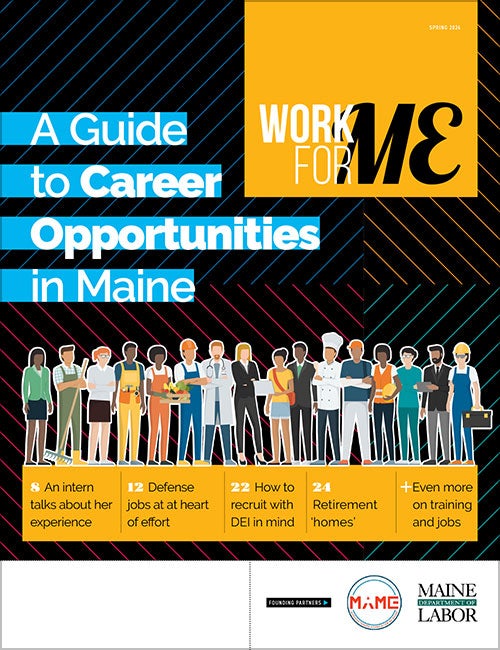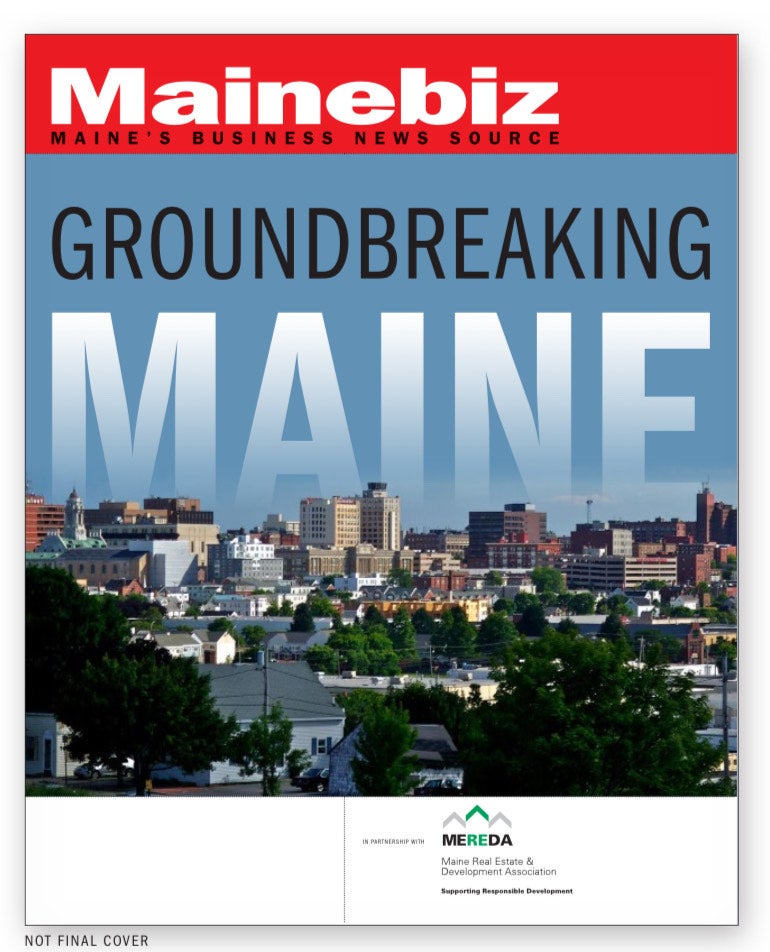Processing Your Payment
Please do not leave this page until complete. This can take a few moments.
Full speed ahead | Fast-growing Sea Bags brings high fashion, green values to the Portland waterfront
Co-owners Beth Shissler and Hannah Kubiak started Sea Bags nearly two years ago, selling Kubiak's handmade bags in Shissler's Isle Au Haut gift shop. Today Sea Bags produces an average of 500 nautical-themed tote bags each month out of recycled sails ˆ so many that that they're preparing to move their 17 employees and eight industrial sewing machines across Custom House Wharf to a much larger space.
Meanwhile, the pair plan on increasing production to 1,000 bags per month to keep up with rising demand. Shissler says Sea Bags' goal throughout their expansion is to keep production in Maine. "We don't want to have our product made overseas," she says. "You can look at the number of businesses that make consumer products and have to go that route. We certainly understand it, and that may limit the amount of production we do."
In 2005, Sea Bags produced 60 bags all year; last year the company churned out 500 bags per month. Shissler notes that sales are "well under" $1 million, but hopes the company will hit that target in the next year or so. (This year, Shissler expects sales to grow 50%.) At the same time the company has done almost no paid advertising other than a few holiday ads in the Wall Street Journal, Portland Press Herald and the Boston Globe. Instead, its exposure, Shissler says, has come from spreads in fashion magazines like Vogue, Elle and the New York Times' Style section that feature Sea Bags alongside pricey products from
Chanel and Prada.
That attention has brought lots of new demand for Sea Bags products. These days, Sea Bags are sold through a handful of online retailers, and Shissler says those sales are growing. But how to handle that increased demand has become a challenge for the company. "We've had a lot of great press coverage from New York to London to Paris, and its really unprecedented to us in terms of demand," she says. "It's a big obstacle for us to figure out."
Charting a course
Cape Porpoise native Kubiak has been sewing tote bags out of sailcloth for six years under the Sea Bags name. But it wasn't until Shissler approached her two years ago that the business really took off. Shissler, who grew up in Topsham and has an M.B.A. from Boston University, at the time was working in Portland as a global account manager for Phillips Electronics. The job required frequent travel ˆ regular trips to Europe and Asia every few weeks ˆ and Shissler figured she'd look for a way out of the corporate world in order to spend more time in Maine. When they started Sea Bags in 2005, there were three full-time employees ˆ Kubiak, Shissler and one sewer. Today the company employs 13 full-time workers and four part-timers.
Both Shissler and Kubiak hope the company's new 1,650-square-foot space, which they estimate will be ready in March, will allow them to better keep up with Sea Bags' furious growth over the last year and a half. The new space is three or four times the size of Sea Bags' current space on Custom House Wharf, and will include room for more sewing machines, a larger design area and a space to cut the sails. "We're so limited by our current space it's ridiculous," says Shissler. "We couldn't get a thousand bags out of this space if we tried."
Right now Sea Bags is producing enough to meet the demand from buyers including Viva Terra, a mail-order catalogue company that sells Sea Bags and other recycled products, and Free People, a division of Urban Outfitters. Last year, Sea Bags pulled 20% of its sales through those stores. And starting this spring Sea Bags totes will be sold in Martin+Osa stores, a branded division of American Eagle Outfitters. The company expects about 15% of sales to come from Martin+Osa.
Those commitments, along with plans for a small retail area in the company's new location has strained the company's ability to keep up with demand. "We're hoping this summer to come out with standard stock bags that we'll always have an inventory of, and that should help our efficiency," says Shissler. "But our business is pretty much at capacity, so our goal right now is to increase that capacity and along with that comes increasing work shifts, sales and raw materials, too."
Part of Sea Bags' success can be traced to the increasing popularity of green fashion ˆ clothing and accessories made from recycled products. Sea Bags has two major competitors in the sailcloth market ˆ True Wind, an Irish company, and Red Flag Design, a Canadian firm that promotes the environmentally friendly aspects of its product.
Shea Gunther is a Portland-based consultant and the publisher of Greenoptions.com, a Web clearinghouse of news and information for people and businesses looking to become more eco-friendly. He thinks that Sea Bags is on the leading edge of a greening trend among small businesses. "People want to live a more environmentally friendly lifestyle, they just don't want to live in a cave to do it," he says. "Anytime you can make a high quality product that helps them connect with that desire, you will be rewarded with their shopping dollars."
Cut the jib
Rapid growth has also meant rapid hiring. When they partnered in 2005, Shissler and Kubiak had one other employee. Today they have 13 full-time workers who sew and design the product, along with four part-time employees who cut sails into smaller pieces for fabrication. Shissler and Kubiak intend to move all their employees to full time before augmenting their workforce. "Our goals are really to let the people who are working part time stay on full time and create growth positions for them," Shissler says. "We really have room to grow them into bigger positionsˆ have some do marketing coordination, help with public relations ˆ real career expansion."
While personnel costs are a big chunk of the company's overhead, the actual raw materials for the bags can be had on the cheap. A new sail can cost as much as $20,000, but most of Sea Bags' sails are donated from sailing programs and marinas in Maine. When the sails arrive at Custom House Wharf they are typically around 40 feet long and 25 feet wide. A team of three part-time cutters break the sails, which are made of Dacron, a strong, water-resistant polyester, into manageable pieces and sends them to the sewing tables for fabrication. "Our cutters are really good at maximizing how many [bags] we get from each sail," says Shissler, who declines to say how many bags can be made from each sail.
Through a number of local initiatives, Sea Bags has been able to boost productivity while staying active in the community. About 30% of the company's bags are produced at the Maine Correctional Institute's Women's Center through a program that teaches inmates work skills while paying a state-funded hourly wage. "We have offered somebody [who was recently released from the Women's Center] a position," she says. "So far, it's a win-win."
Since most of the sails Sea Bags uses are donated, Shissler and Kubiak have launched two programs that collect old sails for recycling and help local sailors. Last year, Sea Bags established a scholarship fund for children at SailMaine, a non-profit sailing school on Portland's waterfront. For each sail the program donates to Sea Bags, the company makes a donation to the fund ˆ last year, enough to put five kids through sailing school, according to Shissler. Sea Bags also donates all the hardware from their sails to the Maine Maritime Academy, which in turn donates its used sails for recycling at Sea Bags.
While Shissler doesn't expect to post the kind of triple- and quadruple-digit growth rates Sea Bags has enjoyed in recent years, she still expects the company to keep growing quickly. "Fifty percent [annual] growth we think is safe, sustainable and doable," she says. But Shissler and Kubiak are enjoying Sea Bag's early success. "We know that we're in high fashion right now, and that [high fashion] is very fickle, so we have to capitalize on that while we can," Shissler notes.
Shissler and Kubiak plan on rolling out new products over the next year. Already they've introduced a signed limited edition Horton-Nichol Seabag to raise $40,000 in support of Andy Horton and Brad Nichol, the only New Englanders competing to represent the U.S. in the 2008 Beijing Olympics, and next month Sea Bags will launch a new breast cancer bag with the goal of raising $15,000 in two months for the Maine Cancer Foundation. "We're always going to do some kind of limited-edition bag to raise money," says Shissler, who adds that the company also is developing new designs to sell in the planned retail store.
Shissler sees Sea Bags as proof that the Portland Waterfront is a viable site for a manufacturing business. "It's expensive in Portland," says Shissler. "There are a lot of resources available, but you have to dig to find them, but we're excited about being a global business in Maine." Being a Maine business ˆ particularly a Portland business ˆ is a core value for Sea Bags, part of the company's corporate identity. "Hannah's dad lives on a boat in Portland, I come from a lobster fishing family, so it's important to us," Shissler says. "We hope to show people that we can be here for a while."










Comments